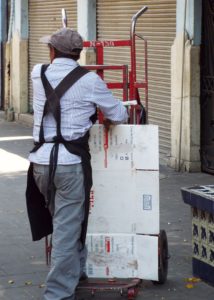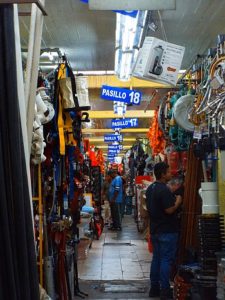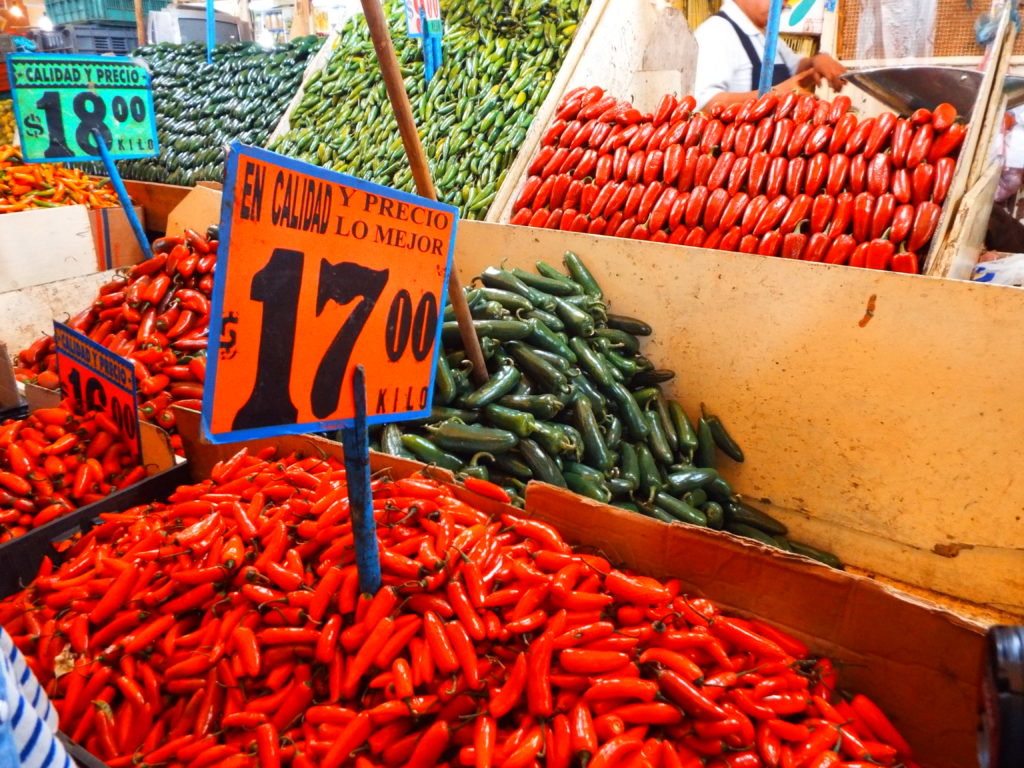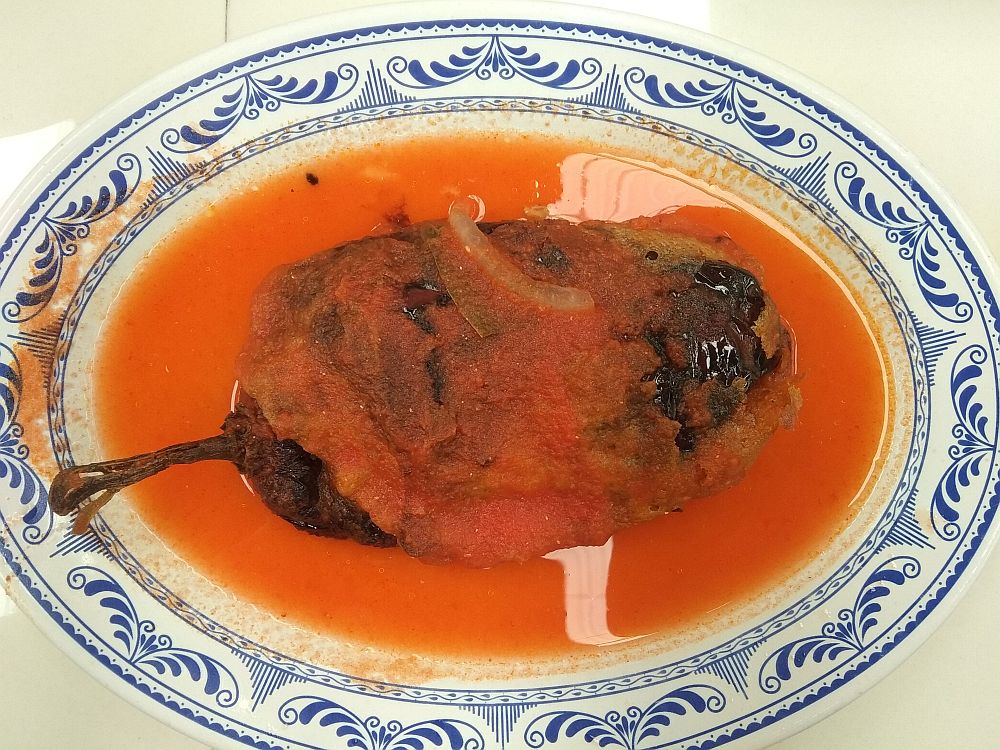Markets are always on peoples’ minds when they come to Mexico City. After all, this one of the many things that makes the city to vibrant and delicious. But what are the markets like — mellow, chaotic, upscale, downhome? And what kind of food, products, and sights do they offer? Here is a limited list of some of the city’s heavy hitters, how they differ and what you can find among their aisles. I hope this makes finding your Mexico City market just a little bit easier.
Mercado Medellin (Mercado Melchor Ocampo)
I list Medellin first because it’s by far my favorite, but I am biased because it’s four blocks from my house and it’s my shopping Cheers. This small neighborhood market is located in the heart of Colonia Roma and has been there (with an earlier tianguis version and a 1930s art deco version) since the colonia was founded. The market has become somewhat famous for its South and Central American products — yucca, malanga, lulu fruit, arepa flour, yerbamate, Bucanero beer, Inka Cola — that started popping up in the 1980s because of demand from clients that immigrated from those countries to Mexico.
The market is slightly more upscale and more expensive than other neighborhood markets of its kind. You can find imported meats and cheeses, organic eggs, craft beer and Cuban ice cream there, as well as the usual mix of meat stands, chicken stands, fish stands, produce, delis, and small eateries and food stands. The market has its own small coffeeshop, one of the neighborhood’s best seafood restaurants (La Morenita), and a flour tortilla mill. There are surprising few street vendors in the streets surrounding the markets except for holidays when a makeshift street market pops up (mainly Christmas and Day of the Dead). This is a market that is easily toured in 45 minutes and unless it’s a Saturday afternoon you will find the mood lively but mellow. Because foreigners are so prevalent in this neighborhood, the market vendors are accustomed to and welcoming of, tourists.
Maybe I am listing the markets in order of favorites? The Merced market is one of the oldest and most important markets in the city. It is also one of the biggest (about the size of 8 football fields), busiest (listen for “aguas!,” it means get out of the way), dirtiest (wear closed-toed shoes) and some say most dangerous. While I know a handful of people that have been pickpocketed here, there is nothing outlandishly dangerous about this market. The biggest worry you have if you go on your own is getting lost, as the market is a labyrinth of streets, buildings, alleyways and side aisles.
The food on offer is tantalizing at every step. My favorite stop for eating being the outside aisle of the market running parallel to Circumvalación Avenue. There you will find a wide range of tacos, lots of pancita (tripe soup), but is tripe a fish? There’s also caldo de gallina (chicken soup) stands, quesadillas, tlacoyos, a fried tamale vendor, and tamales canarios. This is in addition to vendors selling everything from deep purple beans to deep blue corn to deep red chiles. Inside the market’s main building are all the fruit and veggie vendors and there is another building (connected by an underground tunnel) dedicated to meat and cheese. There are 25,000 outside vendors that surround the Merced according to a local newspaper article, and to find your way through them to market itself can be an ordeal.
The market has its own metro stop that will drop you right in to the heart of it, with two exits taking you into the older, street side section of the market, and another, new exit to the revamped section of the market that was renovated after a 2013 fire and still feels somewhat empty. Vendors here are not as friendly as the Medellin and generally don’t appreciate getting their pictures taken (although many of the young men will mug happily for the camera), but if you purchase something from their stand, they are more amiable. I don’t recommend this market to anyone that doesn’t speak Spanish and really insist that is ridiculously easy to get lost and your best bet is to go with someone who knows it (maybe the first, second, and third time). Luckily, I do a tour there so you can come with me!
One of our loveliest markets, the big, warehouse-style building has over 1,000 flower stands, selling everything from chemically dyed cut roses, to meter-high sunflowers and flower arrangements the likes of which you have never seen or imagined. This place is a photographer’s dream. The La Viga canal used to bring farmers and flower vendors right up to one side of the market until it was covered in the 1960s. The food here, as in most markets, is delicious. A great quesadilla stand sits smack dab in the middle of the market, the green chorizo vendor makes amazing tacos near the Morelos street parking lot entrance, and a whole line of esquite vendors on the far side of the building (the aisle that runs parallel with Guillermo Prieto street) draw you in with dozens of different recipes and styles. If you are lucky you will run into the wild mushroom vendor selling during the rainy season or witness the Virgin of Guadalupe altar in all its glory for Day of the Dead.
This market is famous for its Day of the Dead and Christmas markets that set up outside of it along Morelos and Congreso de la Union streets — the pan de muerto bakers fill the place with a sweet haze during October and November and also turn up the heat a bit underneath all the overhead tarps. Many of my friends claim their seafood stands are excellent but I don’t have a favorite so you will have to explore on your own. Other things you can find aplenty here? — dog accessories, ornamental plants, pre-made chopped vegetable soup mixes and masses of piñatas. This is serious local market that draws clientele from all over the city, but plenty of tourists come here too and the vendors are generally friendly and open to having photos taken.
Our gourmet market, the San Juan, is famous for its cold meat and cheese vendors that congregate in the middle of the market and sell baguette sandwiches, little cups of wine, and, if you are lucky, a piece of bread with mascarpone cheese and a smear of honey for dessert. This market is the descendent of the slave market that used to sit in the plaza next door and over time has become a place to buy some of the most outrageous and exotic food items in the city. There are several stands that exclusively sell products from Asia (and a sushi stand if you are so inclined), several that sell edible flowers and vegetable sprouts, a handful of 100% European import stands, a bevy of tropical fruits from around the world, and several stands selling regional and specialty products like Oaxacan cheese and crickets or fancy marmalades.
The seafood section of this market is probably the best in the city and several stands here sell fresh sashimi or ceviches if you want to sit and eat. The meat section is where you can find fresh goat, lamb, turkeys and piglets but where you can also get alligator, ostrich, shark and tiger (farm raised for the majority). Lots of skinned, dead animals here, squeamish be warned. Friday and Saturday afternoons the market is a party with everyone drinking, hanging out and getting ready for the weekend, and that includes lots of tourists. Lots of companies give tours to this market, so don’t expect to be the only foreigner… this is not the place to go to get off the beaten track… but on the upside you might run in to one of the city’s famous chefs, as many of them shop here for specialty items.
The city’s biggest bulk markets, La Viga is solely seafood and fish and the Central de Abastos will sell you anything  you ever wanted. In the 1980s this market was built as a way to draw the overwhelming commerce around the Merced further outside of the city limits. Therefore, this is not a place that is easy to get to on public transportation and will take you around an hour from the center of the city. Best to go with a guide or a local as these two markets span kilometers and sections divided up by product are often intersected by roads and bridges.
you ever wanted. In the 1980s this market was built as a way to draw the overwhelming commerce around the Merced further outside of the city limits. Therefore, this is not a place that is easy to get to on public transportation and will take you around an hour from the center of the city. Best to go with a guide or a local as these two markets span kilometers and sections divided up by product are often intersected by roads and bridges.
These two markets are where you will find the cheapest and often the freshest produce, meat and seafood in the city as everything coming into CDMX goes here first. This is the place that most vendors from smaller markets buy their wares to resell. I am particularly fond of La Viga because I LOVE fish markets and there are dozens of stands selling prepared seafood that make my heart hum. I am still working on a list of my favorites; I will keep you informed. Better to not take fancy  cameras here or act like an asshole tourist, this market is all business. Like I said, go with a local and beware of the diableros.
cameras here or act like an asshole tourist, this market is all business. Like I said, go with a local and beware of the diableros.
I mention this market because it is another favorite. It’s slightly bigger than most of the neighborhood markets and gets a bad rap for being located in Colonia Doctores but really is safe as can be. You may remember this market from another piece I wrote about it, but they have a massive hardware section, super helpful if you are doing any kind of repairs and there is also quite a few delicious food stands, including famous gorditas at El Rinconcito and the brothers that make tepache (a fermented pineapple drink). Part of the market was affected by the fire in 2018 but it’s on its way to being rebuilt. Some surprises? Tiny donuts, vegan tamales, and the grease-filled tostados aisle.
Another market with some hefty longevity, the vendors say that San Cosme has existed in some form for 100 years, that it was once located inside the St. Maria de Ribera neighborhood but moved to its current location on the border between San Rafael and St. Maria duing the mid-1900s. The market sits alongside the metro with the same name so it’s super easy to reach even if you don’t know the city well. It’s a classic neighborhood market, small, about 500 vendors and with all the everyday products you would expect to find — fruit, veggies, meat, chicken (there are no fish or seafood stands here), a section of household goods, a flower section and a few deli-like stands. The market is known as a popular spot in the neighborhood to eat, and its location next to the metro means it’s serving food all day long. In fact, one of its special characteristics is that it’s open until 8pm while most neighborhood markets close at six. Again, this has everything to do with location and the fact that it’s on a major avenue.
So there are a few places I can reccommend now that I took a little tour with Liz Hillbruner, a foodie friend and the owner of La Milpa food tours. The fried quesadilla stand on the Ribera St side of the market is neighborhood-famous and they have an odd diner-like upstairs if you don’t want to sit on the street. Margarita in the center of the market is a lunch counter that sells all kinds of delicious guisados like meatballs in tomato sauce or grilled quelites. And El Carnerito, also in the center of the market, has delicious chiles rellenos, milanesas, and barbacoa tacos. You won’t see many other tourists here, this market is mainly frequented by locals, but the vendors are friendly and the mood is laidback. A sign of the times, there are a dozen or more empty stalls like you will find in most markets, but don’t think that means that this still isn’t an important part of the community, the San Cosme market is alive and well.
Check back for descriptions of more markets coming soon!
Click here to subscribe via RSS





